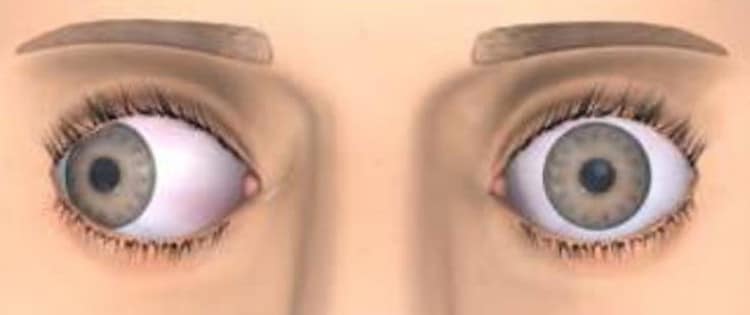Primary Infantile Exotropia
Primary infantile exotropia is a large angle deviation in which the eye is crooked outward from birth, with etiology unknown. It is often characterized by amblyopia and may be associated with craniofacial syndromes (teleorbitism, Apert syndrome, Crouzon syndrome), ocular alterations, central nervous system deficiency, and infantile cerebral paralysis.
Intermittent Exotropia

Exotropia is a misalignment of the eyes in which an eye turns to the outside. In the intermittent form, the eye runs misaligned occasionally. Under normal circumstances, the eyes are straight and perfectly aligned. It usually affects children between one and ten years of age. The frequency and intensity of the eyepiece tend to increase with the age of the patient. The deviation can affect only one or both eyes. Affected children see double very rarely when the eye deviates. More often, they are completely unaware that an eye is devious and has no symptoms because their brain suppresses the image of the deviated eye, and the only symptom can be photophobia. For this reason, though rarely in intermittent exotropia, amblyopia in the deviated eye may appear, which must be treated before surgery. Usually, however, the vision remains good in both eyes because binocularity is exercised in near vision. Surgery is indispensable when other forms of treatment fail to control the deviation. Since the manifestation of strabismus may increase over time, it is preferred to procrastinate surgery beyond six years, in order to avoid having to undertake more interventions. What is important is the optical correction of refractive problems, occlusive therapy for any amblyopia, and in cases where convergence is deficient, orthotic exercises may be useful. These exercises are temporary measures to improve the control of the deviation but are not in any degree to cure it. Surgery: if the orthotic treatment fails to control the deviation and the child is frequently or almost constantly with the deviated eye, the best therapy is surgery. The “timing” of this surgery depends on the child’s age, the frequency of deviation, and binocularity. Most children improve the control of the deviation after surgery, although occasionally, a deviation can be observed.
Consecutive Exotropia
Consecutive exotropia is a spontaneous or iatrogenic evolution of exotropia. Treatment involves the revision of the muscles if they are deficient and their advancement or recovery whenever possible; otherwise, they will opt for a surgical alternative as in a strabismus case.
Surgery for Exotropia
Standard intervention is the recession of lateral rectus muscles when the angle is equal to distant and near, or greater by far. In the presence of excessive divergence, when the deviation is closer to near, a resection of the medial rectus muscles is performed with a deficit of convergence. In the presence of amblyopic deviations, one-sided surgery associated with the medial rectus muscle may be performed.
Video: Intermittent Exotropia
The intermittent exotropia is often asymptomatic because the brain succeeds, when the eye is diverted, to suppress the image of the deviated eye, so it is not disturbed by what is called diplopia: double vision. However, manifestations may also be asthenia and visual fatigue because of the patient’s efforts to keep the eyes straight.
Exotropia can manifest itself more in the eye when looking at objects that are farther away. When the eye turns outward at all distances, at all times, it is called constant exotropia. When both eyes fail to converge normally, this is called convergence insufficiency. Exotropia is also characterized by certain photophobia. In fact, it is often that patients with intermittent exotropia will close an eye in bright environments.
Exotropia can also be congenital. At that point, congenital exotropia is manifested from birth and has very wide deviations that are never totally controlled, so the eye will always be (crooked) outward.
It is often associated with craniofacial syndromes such as (hyperthyroidism) and other pathologies. In these cases, the only approach is surely surgical with the weakening of the muscles. Due to various organic causes, unilateral reduced visual acuity presents a barrier to fusion. In children under 4 years of age, the blind or poorer-seeing eye will generally become esotropic. Older children or adults with sensory visual deprivation will generally develop a sensory exotropia.
Exotropic therapy can sometimes be characterized by simple orthotic exercises. When there is a convergence deficit, sometimes negative lenses can help the patient keep the eyes straighter. If keeping the eyes straight is easily disrupted, say more than half the day with the eye outward or is disturbed by the symptoms that may be related to strabismus, then surgery is certainly needed.





